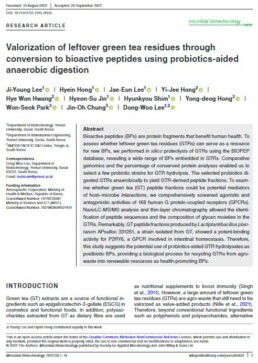Valorization of leftover green tea residues through conversion to bioactive peptides using probiotics-aided anaerobic digestion
Abstract
Bioactive peptides (BPs) are protein fragments that benefit human health. To assess whether leftover green tea residues (GTRs) can serve as a resource for new BPs, we performed in silico proteolysis of GTRs using the BIOPEP database, revealing a wide range of BPs embedded in GTRs. Comparative genomics and the percentage of conserved protein analyses enabled us to select a few probiotic strains for GTR hydrolysis. The selected probiotics digested GTRs anaerobically to yield GTR-derived peptide fractions. To examine whether green tea (GT) peptide fractions could be potential mediators of host–microbe interactions, we comprehensively screened agonistic and antagonistic activities of 168 human G protein-coupled receptors (GPCRs). NanoLC-MS/MS analysis and thin-layer chromatography allowed the identification of peptide sequences and the composition of glycan moieties in the GTRs. Remarkably, GT peptide fractions produced by Lactiplantibacillus plantarum APsulloc 331261, a strain isolated from GT, showed a potent-binding activity for P2RY6, a GPCR involved in intestinal homeostasis. Therefore, this study suggests the potential use of probiotics-aided GTR hydrolysates as postbiotic BPs, providing a biological process for recycling GTRs from agro-waste into renewable resources as health-promoting BPs.
CategoryPeer-reviewed PublicationsDate2022.10Linkami-journals.onlinelibrary.wiley.com
